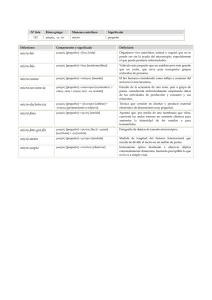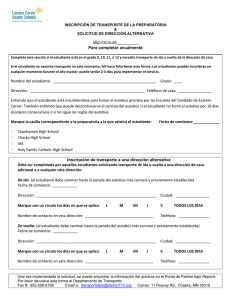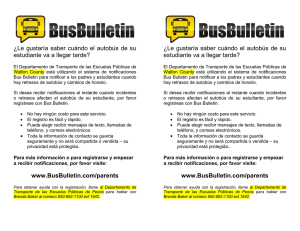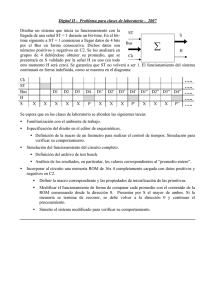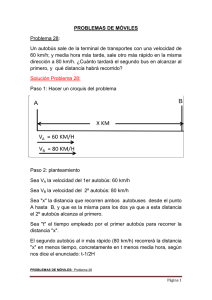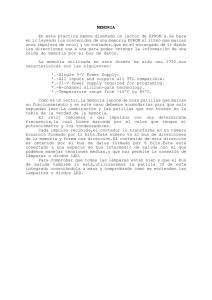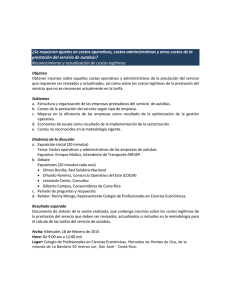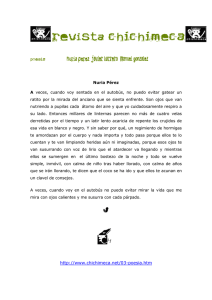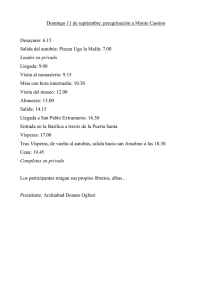Taking Steps to Safety - Gwinnett County Public Schools
Anuncio
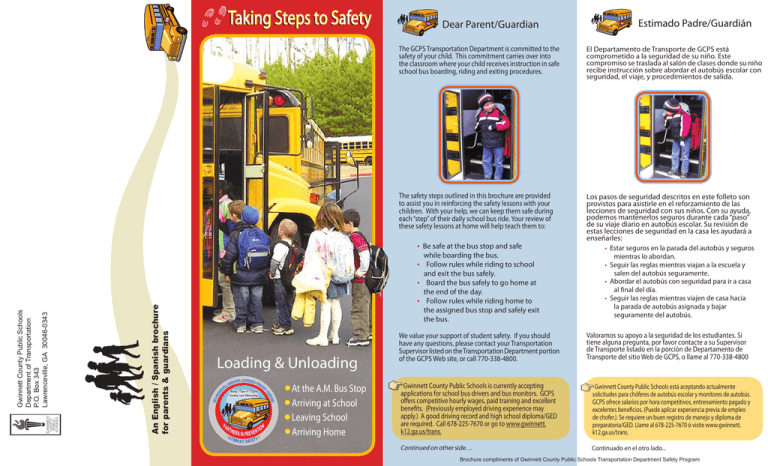
Taking Steps to Safety Dear Parent/Guardian MA BU S NA G MA BU S An English / Spanish brochure for parents & guardians S& ER ITORS STUDENTS PA MON R EN T Taking Steps to Safety Loading and Unloading STU D E N T S A FET Y S RS CHE TEA Gwinnett County Public Schools Department of Transportation P.O. Box 343 Lawrenceville, GA 30046-0343 Loading & Unloading At the A.M. Bus Stop Arriving at School Leaving School Arriving Home The safety steps outlined in this brochure are provided to assist you in reinforcing STUDENTSthe safety lessons with your ORSyour T I children. With help, we Pcan keep them safe during N O of their daily M“step” each schoolARbus ENTride. Your review of & S S teach them to: ERthese safety lessons at home will help Taking Steps to Safety Loading andatUnloading • Be safe the bus stop and safe RS CHE TEA NA G The GCPS Transportation Department is committed to the safety of your child. This commitment carries over into the classroom where your child receives instruction in safe school bus boarding, riding and exiting procedures. while boarding the bus. • Follow rules while riding to school and exit the bus safely. • Board the bus safely to go home at the end of the day. • Follow rules while riding home to the assigned bus stop and safely exit the bus. We value your support of student safety. If you should have any questions, please contact your Transportation Supervisor Department portion S T U listed on the Transportation Y of the GCPS D EWeb E T770-338-4800. N Tsite, S AorFcall Estimado Padre/Guardián El Departamento de Transporte de GCPS está comprometido a la seguridad de su niño. Este compromiso se traslada al salón de clases donde su niño recibe instrucción sobre abordar el autobús escolar con seguridad, el viaje, y procedimientos de salida. Los pasos de seguridad descritos en este folleto son provistos para asistirle en el reforzamiento de las lecciones de seguridad con sus niños. Con su ayuda, podemos mantenerlos seguros durante cada “paso” de su viaje diario en autobús escolar. Su revisión de estas lecciones de seguridad en la casa les ayudará a enseñarles: • Estar seguros en la parada del autobús y seguros mientras lo abordan. • Seguir las reglas mientras viajan a la escuela y salen del autobús seguramente. • Abordar el autobús con seguridad para ir a casa al final del día. • Seguir las reglas mientras viajen de casa hacia la parada de autobús asignada y bajar seguramente del autobús. Valoramos su apoyo a la seguridad de los estudiantes. Si tiene alguna pregunta, por favor contacte a su Supervisor de Transporte listado en la porción de Departamento de Transporte del sitio Web de GCPS, o llame al 770-338-4800 Gwinnett County Public Schools is currently accepting applications for school bus drivers and bus monitors. GCPS offers competitive hourly wages, paid training and excellent benefits. (Previously employed driving experience may apply.) A good driving record and high school diploma/GED are required. Call 678-225-7670 or go to www.gwinnett. k12.ga.us/trans. Gwinnett County Public Schools está aceptando actualmente solicitudes para chóferes de autobús escolar y monitores de autobús. GCPS ofrece salarios por hora competitivos, entrenamiento pagado y excelentes beneficios. (Puede aplicar experiencia previa de empleo de chofer.). Se requiere un buen registro de manejo y diploma de preparatoria/GED. Llame al 678-225-7670 ó visite www.gwinnett. k12.ga.us/trans. Continued on other side… Continuado en el otro lado... Brochure compliments of Gwinnett County Public Schools Transportation Department Safety Program Please help us educate your children in school bus safety. Por favor ayúdenos a educar a sus niños acerca de la seguridad en autobuses escolares. Step 1: Morning – Going to School Paso 1: De Mañana – Yendo a la Children should: • Place school work in a bookbag (make sure bag does not have loose straps that could get caught on the handrail or bus door). • Leave home in time to walk to the bus stop. Be there 5 minutes before the bus arrives. • Do not chase after the bus. • Stand back from the road, away from moving vehicles. • Do not play around at the stop. Stand in a line to wait for the bus. • Wait for the Bus Manager’s signal that it’s safe to cross the road (for crossers). • Check the traffic before crossing, looking left, right, and left again. • Look at the driver. If they cannot see the driver, move further away from the bus. • Use the handrail when going up the bus steps, look for loose bookbag straps or jacket strings. Step 2: Arriving at School Children should: • Stay seated until the bus door opens. .............Escuela Los niños deben: • Colocar el trabajo escolar en una mochila (asegúrese que la mochila no tenga correas sueltas que pudieran atorarse en el pasamanos o en la puerta del autobús). • Dejar la casa a tiempo para caminar a la parada del autobús. Estar ahí 5 minutos antes de que llegue el autobús. • No perseguir el autobús. • Permanecer lejos de la calle, apartado de vehículos móviles. • No jugar alrededor de la parada. permanecer en una fila para esperar por el autobús. • Esperar la señal del Gerente del Autobús de que es seguro cruzar la calle (para quienes cruzan). • Verificar el tráfico antes de cruzar, viendo a la izquierda, derecha y nuevamente a la izquierda. • Observar al chofer. Si no pueden ver al chofer, alejarse aun más del autobús. • Usar el pasamanos cuando suba los escalones del autobús, observar que no hayan correas sueltas de mochilas o cordones de chaquetas. Paso 2: Llegando a la Escuela Los niños deben: • Permanecer sentado hasta que la puerta del autobús se abra. • Unload one seat at a time. • Bajar un solo asiento a la vez. • Use the handrail when walking down • Usar el pasamanos cuando baje los escalones. the steps. • Look for loose bookbag straps and jacket strings. • Walk, don’t run into the school. • Observar que no hayan correas sueltas de mochilas o cordones de chaquetas. • Caminar, no correr hacia la escuela. Brochure compliments of Gwinnett County Public Schools Transportation Department Safety Program Step 3: Afternoon – Leaving School Children should: • Place school work in a bookbag. • Walk quietly to their bus. • Look for the correct route number before entering the bus. • Use the handrail; look for loose bookbag straps and jacket strings. • Sit in their assigned seat, with legs in front of them (bottom and back against the seat). • Place their bookbag on their lap. Step 4: Afternoon – Arriving Home Children should: • Get off the bus at their assigned bus stop only. • Wait for the bus to stop and the door to open before standing up. • Use the handrail, check for loose bookbag straps and jacket strings. • Look right and left before stepping off the bus, watch for cars that may not stop. • Stay out of the Danger Zones, at least 3 giant steps away from the bus. • Look at the Bus Manager for a crossing signal, if they are crossing the road. • Check the traffic for themselves, looking left, right and left again. The Danger Zones are the areas around the school bus where the driver cannot see a child. If an item is dropped, the child should wave their arms high above their head to get the attention of the driver before picking up what they have dropped. Students must be within the eyesight of the driver at all times. All GCPS students are educated in school bus emergencies. If an emergency does occur, please tell your child to stay calm and listen to the driver. If they need to evacuate the bus, they should leave their bookbags and personal items, and sit and scoot out of the emergency door, using the shoulders or fist of the helpers. The school will notify the parents if a school bus emergency happens. Paso 3: Por la Tarde – Saliendo de .............la Escuela Los niños deben: • Colocar el trabajo escolar en una mochila. • Caminar tranquilamente a su autobús. • Verificar el número correcto de ruta antes de subir al autobús. • Usar el pasamanos; observar que no hayan correas sueltas de mochilas o cordones de chaquetas. • Sentarse en su asiento asignado, con las piernas en frente de ellos (trasero y espalda recargada contra el asiento). • Colocar su mochila en su regazo. Paso 4: Por la Tarde – .............Llegando a Casa Los niños deben: • Bajar del autobús solamente en sus paradas de autobús asignadas. • Esperar que el autobús se detenga y se abra la puerta antes de ponerse de pie. • Usar el pasamanos, observar que no hayan correas sueltas de mochilas o cordones de chaquetas. • Observar a la derecha e izquierda antes de bajarse del autobús; observar por carros que pudieran no detenerse. • Permanecer fuera de Zonas de Peligro, al menos 3 pasos gigantes lejos del autobús. • Observar al Encargado del Autobús para una señal de cruce, si van a cruzar el camino. • Observar el tráfico por si mismos, volteando a la izquierda, derecha y nuevamente a la izquierda Las Zonas de Peligro son las áreas alrededor del autobús escolar donde el chofer no puede ver a un niño. Si se cae un objeto, el niño debe agitar los brazos en alto por encima de su cabeza para atraer la atención del chofer antes de recoger lo que se le haya caído. Los estudiantes deben de estar a la vista del chofer en todo momento. Todos los Estudiantes de GCPS están educados en emergencias de autobús escolar. Si ocurre una emergencia, por favor dígale a su niño que permanezca calmado y escuche al chofer. Si necesitan evacuar el autobús, deben dejar sus mochilas y artículos personales, sentarse y deslizarse por la puerta de emergencia, usando los hombros o el puño de los ayudantes. La escuela notificará a los padres si ocurre una emergencia de autobús escolar.
